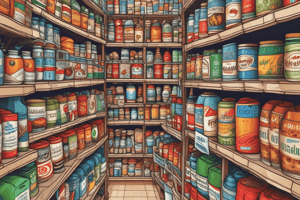Podcast
Questions and Answers
What should not be present in fresh fish to indicate it is of good quality?
What should not be present in fresh fish to indicate it is of good quality?
- Clear, bulging eyes
- Firm and elastic flesh
- Bright red, moist gills
- Cloudy eyes (correct)
Which factor is critical to avoid during the receiving of food products?
Which factor is critical to avoid during the receiving of food products?
- Inspection for insect infestation
- Proper temperature of storage areas
- Acceptance of underweight merchandise (correct)
- Hiring additional staff
What method is essential for effective food storage?
What method is essential for effective food storage?
- JIT Method
- FIFO Method (correct)
- LIFO Method
- OFT Method
What should you check for when inspecting packaged foods?
What should you check for when inspecting packaged foods?
What is the recommended practice for washing fruits and vegetables before use?
What is the recommended practice for washing fruits and vegetables before use?
Which of the following is NOT considered a Properly Hazardous Food (PHF)?
Which of the following is NOT considered a Properly Hazardous Food (PHF)?
What is a sign that food might be unsafe to consume?
What is a sign that food might be unsafe to consume?
What is a significant risk associated with poor receiving procedures?
What is a significant risk associated with poor receiving procedures?
What is the main goal of Good Agricultural Practices (GAPs)?
What is the main goal of Good Agricultural Practices (GAPs)?
Which practice is NOT specifically mentioned as a trigger for handwashing?
Which practice is NOT specifically mentioned as a trigger for handwashing?
What is the primary purpose of using separate equipment for raw foods and ready-to-eat (RTE) foods?
What is the primary purpose of using separate equipment for raw foods and ready-to-eat (RTE) foods?
Which component is essential for a handwashing sink as per the safety requirements?
Which component is essential for a handwashing sink as per the safety requirements?
Which pest is commonly associated with retail food establishments and prefers cereal products?
Which pest is commonly associated with retail food establishments and prefers cereal products?
Good Retail Practices (GRPs) primarily focus on which aspect?
Good Retail Practices (GRPs) primarily focus on which aspect?
What key aspect should be addressed in an integrated pest management (IPM) program?
What key aspect should be addressed in an integrated pest management (IPM) program?
What is one of the challenges faced by Food Safety Management Programs (FSMP)?
What is one of the challenges faced by Food Safety Management Programs (FSMP)?
Which of the following is a provision included for safe food handling?
Which of the following is a provision included for safe food handling?
What is a recommended practice for garbage disposal in food establishments?
What is a recommended practice for garbage disposal in food establishments?
When should handwashing be conducted according to food safety guidelines?
When should handwashing be conducted according to food safety guidelines?
Which type of footwear is advised for employees working in retail food establishments?
Which type of footwear is advised for employees working in retail food establishments?
What is one goal of Good Manufacturing Practices (GMP)?
What is one goal of Good Manufacturing Practices (GMP)?
Which of the following actions is NOT recommended when preparing foods?
Which of the following actions is NOT recommended when preparing foods?
What is one acceptable method for thawing food?
What is one acceptable method for thawing food?
Which of the following practices helps prevent cross-contamination in food service areas?
Which of the following practices helps prevent cross-contamination in food service areas?
What is considered a common rodent in retail food establishments?
What is considered a common rodent in retail food establishments?
Which procedure should be used for lifting heavy items safely?
Which procedure should be used for lifting heavy items safely?
Why is cooking food important?
Why is cooking food important?
What should be avoided when serving ready-to-eat (RTE) foods?
What should be avoided when serving ready-to-eat (RTE) foods?
What is the minimum height food should be stored off the floor to allow proper air circulation?
What is the minimum height food should be stored off the floor to allow proper air circulation?
How long should hands be scrubbed with soap when washing?
How long should hands be scrubbed with soap when washing?
What is the best practice for serving food to prevent contamination?
What is the best practice for serving food to prevent contamination?
What is the first step in the handwashing process?
What is the first step in the handwashing process?
What should never be done with ice used for beverages?
What should never be done with ice used for beverages?
When preparing food, what is the key factor that must not be compromised?
When preparing food, what is the key factor that must not be compromised?
How should raw products be stored in relation to cooked or ready-to-eat foods?
How should raw products be stored in relation to cooked or ready-to-eat foods?
Which of the following is NOT a good manufacturing practice?
Which of the following is NOT a good manufacturing practice?
What is the recommended approach for cooling food?
What is the recommended approach for cooling food?
What environment is ideal for dry storage of food?
What environment is ideal for dry storage of food?
What should you do to prevent cross-contamination in a food prep area?
What should you do to prevent cross-contamination in a food prep area?
What is the correct method for transferring food to ensure safe cooling?
What is the correct method for transferring food to ensure safe cooling?
What is the purpose of establishing a Critical Limit (CL) for a Critical Control Point (CCP)?
What is the purpose of establishing a Critical Limit (CL) for a Critical Control Point (CCP)?
Which principle of HACCP involves taking corrective action when a critical limit is not met?
Which principle of HACCP involves taking corrective action when a critical limit is not met?
What forms the basis for establishing Critical Limits (CL) in HACCP?
What forms the basis for establishing Critical Limits (CL) in HACCP?
What is the primary role of monitoring in HACCP?
What is the primary role of monitoring in HACCP?
Which of the following statements best describes the verification procedure within HACCP?
Which of the following statements best describes the verification procedure within HACCP?
In the context of HACCP, what is the significance of record keeping?
In the context of HACCP, what is the significance of record keeping?
Which aspect is NOT typically included in a product-specific HACCP program?
Which aspect is NOT typically included in a product-specific HACCP program?
What may be included as a corrective action when a critical limit is not met?
What may be included as a corrective action when a critical limit is not met?
Flashcards
FIFO Method
FIFO Method
The practice of rotating stock in a storage area to ensure older products are used first.
Refrigerated and Frozen Storage Areas
Refrigerated and Frozen Storage Areas
Areas that should be clean, free from infestation, and properly maintained to prevent food contamination.
Receiving
Receiving
Incoming food items should be inspected thoroughly for any signs of damage or contamination.
Cooling
Cooling
Signup and view all the flashcards
Proper Separation of Food and Non-food Items
Proper Separation of Food and Non-food Items
Signup and view all the flashcards
Checking Canned Goods
Checking Canned Goods
Signup and view all the flashcards
Temperature Danger Zone (TDZ)
Temperature Danger Zone (TDZ)
Signup and view all the flashcards
Inspecting Fresh Fish
Inspecting Fresh Fish
Signup and view all the flashcards
Cooking's Purpose
Cooking's Purpose
Signup and view all the flashcards
Refrigerator Thawing
Refrigerator Thawing
Signup and view all the flashcards
Thawing Under Cool Water
Thawing Under Cool Water
Signup and view all the flashcards
Microwave Thawing
Microwave Thawing
Signup and view all the flashcards
Preventing Cross-contamination
Preventing Cross-contamination
Signup and view all the flashcards
Good Manufacturing Practices (GMPs)
Good Manufacturing Practices (GMPs)
Signup and view all the flashcards
Handwashing
Handwashing
Signup and view all the flashcards
Sanitize Hands
Sanitize Hands
Signup and view all the flashcards
Why store food 6 inches off the floor?
Why store food 6 inches off the floor?
Signup and view all the flashcards
Why use shallow containers for cooling?
Why use shallow containers for cooling?
Signup and view all the flashcards
Why store raw products below cooked food?
Why store raw products below cooked food?
Signup and view all the flashcards
What is proper handwashing?
What is proper handwashing?
Signup and view all the flashcards
What is temperature abuse?
What is temperature abuse?
Signup and view all the flashcards
Why separate food and nonfood items?
Why separate food and nonfood items?
Signup and view all the flashcards
Why clean and sanitize during food prep?
Why clean and sanitize during food prep?
Signup and view all the flashcards
What are good personal hygiene practices when serving food?
What are good personal hygiene practices when serving food?
Signup and view all the flashcards
HACCP
HACCP
Signup and view all the flashcards
Critical Control Point (CCP)
Critical Control Point (CCP)
Signup and view all the flashcards
Critical Limit (CL)
Critical Limit (CL)
Signup and view all the flashcards
Hazard Analysis
Hazard Analysis
Signup and view all the flashcards
Monitoring CCPs
Monitoring CCPs
Signup and view all the flashcards
Corrective Action
Corrective Action
Signup and view all the flashcards
Verification
Verification
Signup and view all the flashcards
Record Keeping
Record Keeping
Signup and view all the flashcards
Good Agricultural Practices (GAPs)
Good Agricultural Practices (GAPs)
Signup and view all the flashcards
Good Retail Practices (GRPs)
Good Retail Practices (GRPs)
Signup and view all the flashcards
Food Safety Management Program (FSMP)
Food Safety Management Program (FSMP)
Signup and view all the flashcards
Focus on Risk
Focus on Risk
Signup and view all the flashcards
Manageable FSMP
Manageable FSMP
Signup and view all the flashcards
Strengthen Communication
Strengthen Communication
Signup and view all the flashcards
Cleaning and Sanitizing
Cleaning and Sanitizing
Signup and view all the flashcards
Color-coding for food prep
Color-coding for food prep
Signup and view all the flashcards
Clean and sanitized equipment
Clean and sanitized equipment
Signup and view all the flashcards
Preparing RTE foods first
Preparing RTE foods first
Signup and view all the flashcards
Pest control in food establishments
Pest control in food establishments
Signup and view all the flashcards
Integrated pest management (IPM)
Integrated pest management (IPM)
Signup and view all the flashcards
Trash and waste disposal
Trash and waste disposal
Signup and view all the flashcards
Proper footwear in food establishments
Proper footwear in food establishments
Signup and view all the flashcards
Employee safety training
Employee safety training
Signup and view all the flashcards
Study Notes
Safety Standards in Food Product Flow
- Receiving: Poor receiving procedures increase the chance of theft, accepting underweight merchandise and contamination/waste resulting from accepting products not meeting specifications. Always check packaged foods for leaks, bulges, dents, broken seals, damage, rust and missing labels.
- Red Meat: Fresh meat should be firm and elastic. "Off" odors and sliminess indicate spoilage. Frozen meat must be received frozen and packaged to prevent freezer burn.
- Poultry: Chicken, turkey, duck, and geese should be without "off" odors or soft meat tissues (signs of spoilage). Sticky wings and darkened wing tips are indicators for rejecting poultry.
- Eggs: Eggs should be firm, white should cling to yolk, free of noticeable odor and cracks.
- Fish: Fresh fish have a mild pleasant odor, bright, shiny scales, bulging eyes and bright red, moist gills. Fish flesh should be firm and elastic.
- Vegetables/Fruits: Raw produce, generally not considered hazardous, should be thoroughly washed. Purchase from approved suppliers and wash thoroughly to remove contaminants before being cut, combined with other ingredients, cooked or served.
- Storage: Stock rotation, FIFO (First In, First Out), is important. Utilize dry storage, refrigerators, and freezers.
Food Preparation
- Food Preparation: "Small batch" preparation, avoid temperature abuse, and good handwashing are essential. Use four acceptable thawing methods: under cool running water, in a microwave (followed by immediate cooking), in a refrigerator, or as part of the cooking process.
- Cooking: Cooking heats food and destroys harmful microorganisms.
Serving Food
- Serving Food: Always practice good personal hygiene. Do not touch food or surfaces with bare hands. Hold utensils by the handles and do not touch rims of glasses. Handle plates and bowls by the bottom or outer rim. Be mindful of cross-contamination.
Studying That Suits You
Use AI to generate personalized quizzes and flashcards to suit your learning preferences.




